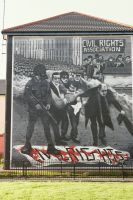
'Bloody Sunday', 30 January 1972 - Summary of Main Events[KEY_EVENTS] [Key_Issues] [Conflict_Background] 'BLOODY SUNDAY': [Menu] [Reading] [Summary] [Chronology] [Dead] [Circumstances] [Background] [Events] [Photographs] [Sources] Material is added to this site on a regular basis - information on this page may change
The soldiers responsible for the deaths and injuries insisted that they had come under sustained gun and bomb attack by members of the Irish Republican Army (IRA) and only fired at people in possession of weapons. Those involved in the march, and those who witnessed the events, provided evidence that ran contrary to the evidence given by the soldiers. According to these civilian testimonies none of those killed or injured had any guns or bombs. The events of 'Bloody Sunday' caused a lot of shock and revulsion at an international level. Within Ireland the killings resulted in a dramatic increase in support for Republicanism in general and the IRA in particular. The strength of feeling was demonstrated when a crowd of protestors burnt the British embassy in Dublin on 2 February 1972. Immediately after the killings the British government announced the appointment of Lord Widgery, then Lord Chief Justice, to undertake an inquiry into the events of the day. Many people were skeptical of the impartiality of Widgery and were not reassured when it was decided to hold the Tribunal in Coleraine - a town 32 miles from the scene of the killings. The hearings of the Tribunal were conducted between 21 February 1972 and the 14 March 1972. Many key witnesses, including some of those shot and injured, were not called to the Tribunal. The report of the Tribunal was published on 18 April 1972. Widgery found no fault on the part of the soldiers who fired live rounds on the day but stated that there was a "strong suspicion" that some of those killed "had been firing weapons or handling bombs". Over a period of many years the relatives of those killed on 30 January 1972 campaigned for a fresh inquiry into the killings. On 29 January 1998 Tony Blair, then British Prime Minister, announced that there would be a new inquiry under the chairmanship of Lord Saville. Main hearings of the new Inquiry took place between March 2000 and January 2005 making it one of the longest and most expensive in British legal history. The final report and conclusions of the Bloody Sunday Inquiry were initially expected to be published in the summer of 2005. There were many delays before the report was published on 15 June 2010. Many people in the Unionist community have criticised the cost of the Saville Inquiry and the extent of media attention given to the killings of 'Bloody Sunday' and point to the contrast with a number of other major incidents involving paramilitary groups which receive less attention. Part of the reason for this difference is the fact that the Widgery Report into 'Bloody Sunday' left doubts about the innocence of those killed whereas no such doubts are attached to those killed, for instance, in the Omagh bombing. In addition those who died in other major incidents were killed by members of various paramilitary groups. However, in Derry it was state forces, in the form of the British Army, the very people who were meant to protect life and uphold law and order, who carried out the killings.
|
CAIN
contains information and source material on the conflict
and politics in Northern Ireland. CAIN is based within Ulster University. |
|
|
|||
|
Last modified :
|
||
|
| ||
